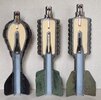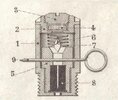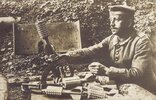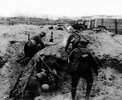pzgr40
Well-Known Member
Cutaway models of German WW1 Wurfgranaten for the Granatenwerfer 16. The Wurfgranate with the round head is the first model (model 14), the ones with the cilindrical head (model 15) was the later model. The Granatenwerfer 16 was the ideal weapon for trench warfare , especialy as the Granatenwerfer 16 was a light weapon with relatively few parts that could easily be carried by one man, conveniant in the endless mudfields where heavier weapons got stuck and even sunk away in the mud.
Originally the weapon was known as the ‘Priestwerfer’ as the weapon was designed by a Hungarian Priest called Vecar. In the beginning it was used by the Austrian Hungarin troops , but soon the German army recognized the value of the weapon for it’s own use. There were a few different versions of the weapon as to dimensions and castings, but only one part had to be made to the same precise dimensional specifications for all versions; the diameter and length of the spigot.
The grenade body for all versions was made from cast iron and was filled with 255 grams of Westfalit (Ammonium Nitrate) The tail pipe is steel made. The tail fins are sheet steel and are found with three and four fins, used for both the model 14 and the model 15 warheads. Inside the steel pipe of the tail a chamber is drilled in top housing a 7,92x57 propulsion cartridge. If the grenade is placed over the spigot, the firing cap of the propulsion cartridge is placed over the hole of the firing pin in the spigot. When pulling the firing lever the propulsion cartridge is ignited, launching the grenade from the spigot. The minimal range of the grenade is 50 meters, the maximum range is 300 meters, ideal for direct and indirect fire in trench warfare against dug in troops, sentry posts and machine gun nests.
Exept for the two versions shown here, there was a grenade with a bounding function, exploding 3 to 4 foot above the ground after impact, a smoke grenade, a propaganda grenade with leaflets, an illuninating round, and a message round used to send written messages from one German trench to another German trench.
Length and diameter of the wurfgranate model 14 : 260mm / 85mm
Length and diameter of the wurfgranate model 15 : 275mm / 70 mm
Diameter of the steel tail shaft : 33m mm for all models
A trained crew could fire 250 to 300 rounds per hour
Picture 03:
The Wurfgranatenzunder (W.Gr.zdr) is a simple but sensitive fuze. In rest a safetypin (9) is placed through the fuze body (1) and inertia weight (5) of the fuze. On top of the inertia weight the firing pin (6) is placed. On both sides of the firing pin an angeld hole is drilled to the center of the inertia weight, ending in a hollow chamber in the base of the inertia weight which is filled with a pipe of pressed black powder (8) . This black powder amplifies the flame of the firing cap when moving into the detonator. The firing cap (4) is placed in the top cap (2) of the fuze. Between the firing pin and firing cap a pressure spring (7) is placed.
Before firing –with the grenade placed on the spigot- the safety pin is removed. Upon firing, inertia keeps the inertia weight in the lower position. In the downward part of the flight trajectory the pressure spring keeps the firing cap and the firing pin apart. Upon impact, inertia moves the inertia weight forward -riding the spring-, moving the firing pin into the firing cap. The strengthened flame of the firing cap ignites the detonator, exploding the grenade.
Among the French troops the grenade was called the ‘Tourterelle’ (pigion), after the particular warbling sound in the descending part of the flight. However, when this sound was heard it was often too late to take cover. Normaly the Granatenwerfer 16 ’s were used in groups of four, spaced 15 to 20 meters apart, to prevent them from being destroyed by enemy counterbattery fire all at once.
The wurfgranate 14 and 15 were also used as aircraft bombs; after removing the safety pin the bombs were thrown from airplanes by hand.
The Granatenwerfer 16 was used by the following countries:
German Empire, Austro-Hungarian Empire, Kingdom of Bulgaria, Ottoman Empire and Poland.
Regards, DJH
Originally the weapon was known as the ‘Priestwerfer’ as the weapon was designed by a Hungarian Priest called Vecar. In the beginning it was used by the Austrian Hungarin troops , but soon the German army recognized the value of the weapon for it’s own use. There were a few different versions of the weapon as to dimensions and castings, but only one part had to be made to the same precise dimensional specifications for all versions; the diameter and length of the spigot.
The grenade body for all versions was made from cast iron and was filled with 255 grams of Westfalit (Ammonium Nitrate) The tail pipe is steel made. The tail fins are sheet steel and are found with three and four fins, used for both the model 14 and the model 15 warheads. Inside the steel pipe of the tail a chamber is drilled in top housing a 7,92x57 propulsion cartridge. If the grenade is placed over the spigot, the firing cap of the propulsion cartridge is placed over the hole of the firing pin in the spigot. When pulling the firing lever the propulsion cartridge is ignited, launching the grenade from the spigot. The minimal range of the grenade is 50 meters, the maximum range is 300 meters, ideal for direct and indirect fire in trench warfare against dug in troops, sentry posts and machine gun nests.
Exept for the two versions shown here, there was a grenade with a bounding function, exploding 3 to 4 foot above the ground after impact, a smoke grenade, a propaganda grenade with leaflets, an illuninating round, and a message round used to send written messages from one German trench to another German trench.
Length and diameter of the wurfgranate model 14 : 260mm / 85mm
Length and diameter of the wurfgranate model 15 : 275mm / 70 mm
Diameter of the steel tail shaft : 33m mm for all models
A trained crew could fire 250 to 300 rounds per hour
Picture 03:
The Wurfgranatenzunder (W.Gr.zdr) is a simple but sensitive fuze. In rest a safetypin (9) is placed through the fuze body (1) and inertia weight (5) of the fuze. On top of the inertia weight the firing pin (6) is placed. On both sides of the firing pin an angeld hole is drilled to the center of the inertia weight, ending in a hollow chamber in the base of the inertia weight which is filled with a pipe of pressed black powder (8) . This black powder amplifies the flame of the firing cap when moving into the detonator. The firing cap (4) is placed in the top cap (2) of the fuze. Between the firing pin and firing cap a pressure spring (7) is placed.
Before firing –with the grenade placed on the spigot- the safety pin is removed. Upon firing, inertia keeps the inertia weight in the lower position. In the downward part of the flight trajectory the pressure spring keeps the firing cap and the firing pin apart. Upon impact, inertia moves the inertia weight forward -riding the spring-, moving the firing pin into the firing cap. The strengthened flame of the firing cap ignites the detonator, exploding the grenade.
Among the French troops the grenade was called the ‘Tourterelle’ (pigion), after the particular warbling sound in the descending part of the flight. However, when this sound was heard it was often too late to take cover. Normaly the Granatenwerfer 16 ’s were used in groups of four, spaced 15 to 20 meters apart, to prevent them from being destroyed by enemy counterbattery fire all at once.
The wurfgranate 14 and 15 were also used as aircraft bombs; after removing the safety pin the bombs were thrown from airplanes by hand.
The Granatenwerfer 16 was used by the following countries:
German Empire, Austro-Hungarian Empire, Kingdom of Bulgaria, Ottoman Empire and Poland.
Regards, DJH
Attachments
-
 01 - Wurfgranaten 14 en 15 achterzijde.jpg3.5 MB · Views: 40
01 - Wurfgranaten 14 en 15 achterzijde.jpg3.5 MB · Views: 40 -
 02 - Wurfgranaten 14 en 15 doorsneden.jpg5.1 MB · Views: 41
02 - Wurfgranaten 14 en 15 doorsneden.jpg5.1 MB · Views: 41 -
 03 - W.Gr. Fuze.jpg33.7 KB · Views: 39
03 - W.Gr. Fuze.jpg33.7 KB · Views: 39 -
 04 - Granatenwerfer 16.jpg7 MB · Views: 28
04 - Granatenwerfer 16.jpg7 MB · Views: 28 -
 05 - Granatenwerfer 16.jpg93.4 KB · Views: 22
05 - Granatenwerfer 16.jpg93.4 KB · Views: 22 -
 06 - Granatenwerfer 16 in Flanders 1917.jpg296 KB · Views: 30
06 - Granatenwerfer 16 in Flanders 1917.jpg296 KB · Views: 30
Last edited:
